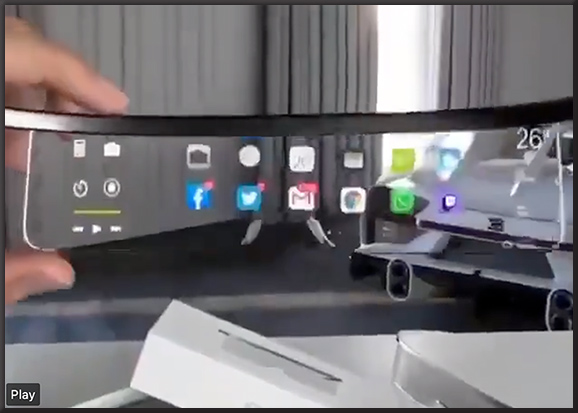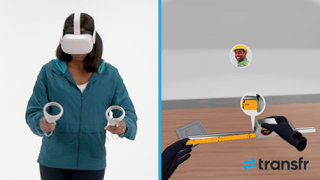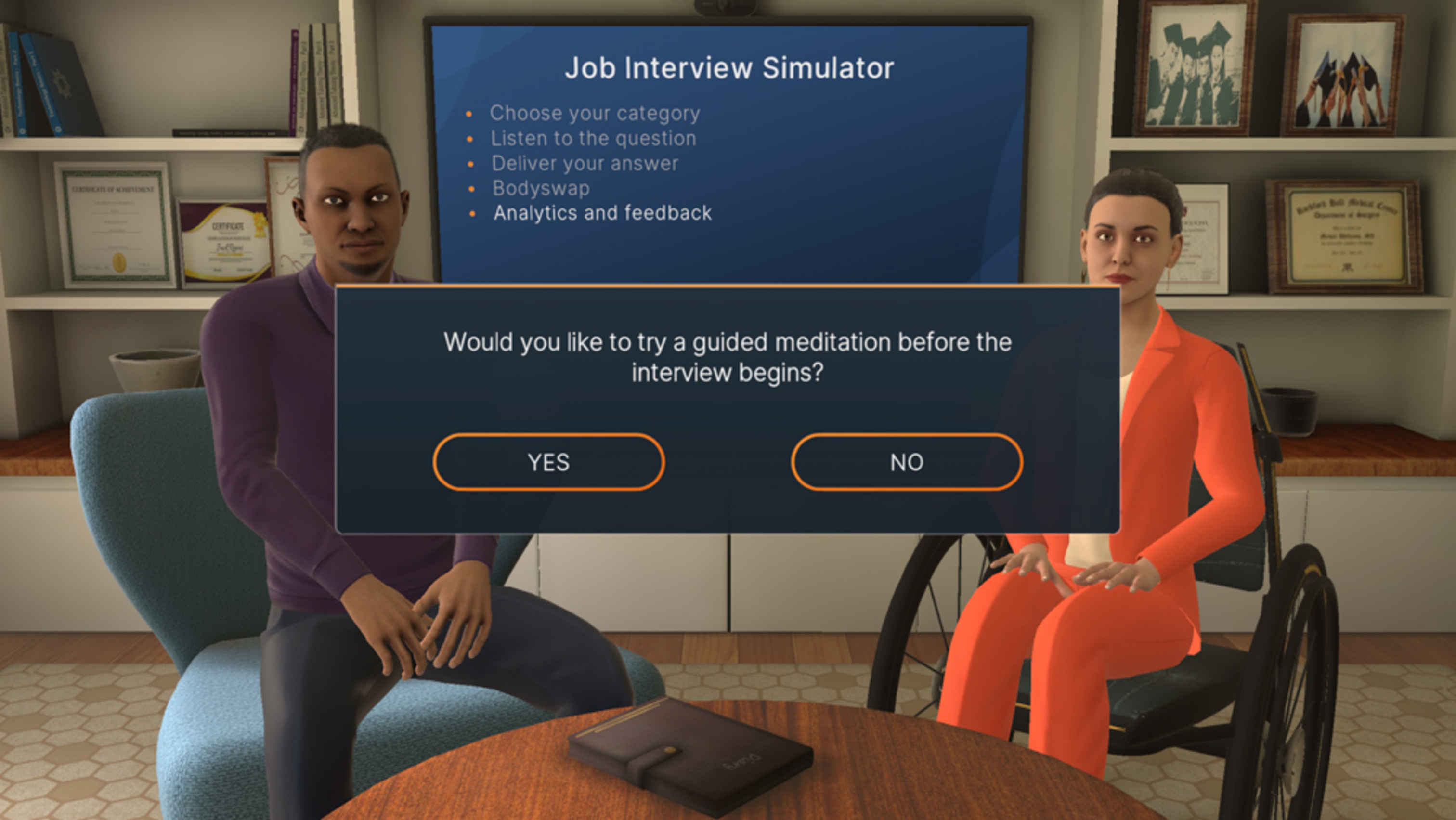VR & robotics could be the future of medical training — from vrscout.com by Kyle Melnick
FundamentalVR is partnering with Haply Robotics to provide more realistic VR surgical simulations.

Also relevant/see:




VR & robotics could be the future of medical training — from vrscout.com by Kyle Melnick
FundamentalVR is partnering with Haply Robotics to provide more realistic VR surgical simulations.

Also relevant/see:
Explore Breakthroughs in AI, Accelerated Computing, and Beyond at GTC — from nvidia.com
The Conference for the Era of AI and the Metaverse
Addendums on 3/22/23:
Generative AI for Enterprises — from nvidia.com
Custom-built for a new era of innovation and automation.
Excerpt:
Impacting virtually every industry, generative AI unlocks a new frontier of opportunities—for knowledge and creative workers—to solve today’s most important challenges. NVIDIA is powering generative AI through an impressive suite of cloud services, pre-trained foundation models, as well as cutting-edge frameworks, optimized inference engines, and APIs to bring intelligence to your enterprise applications.
NVIDIA AI Foundations is a set of cloud services that advance enterprise-level generative AI and enable customization across use cases in areas such as text (NVIDIA NeMo™), visual content (NVIDIA Picasso), and biology (NVIDIA BioNeMo™). Unleash the full potential with NeMo, Picasso, and BioNeMo cloud services, powered by NVIDIA DGX™ Cloud—the AI supercomputer.
Before ChatGPT ??
Research:
Read articles from multiple sites.Marketing:
Read articles from multiple sites.Copywriting:
Read articles from multiple sites.After ChatGPT ??
Do Anything:
Ask the right prompts [ The most valuable skill in 2023 ]— Harsh Makadia (@MakadiaHarsh) February 23, 2023
9 ways ChatGPT will help CIOs — from enterprisersproject.com by Katie Sanders
What are the potential benefits of this popular tool? Experts share how it can help CIOs be more efficient and bring competitive differentiation to their organizations.
Excerpt:
Don’t assume this new technology will replace your job. As Mark Lambert, a senior consultant at netlogx, says, “CIOs shouldn’t view ChatGPT as a replacement for humans but as a new and exciting tool that their IT teams can utilize. From troubleshooting IT issues to creating content for the company’s knowledge base, artificial intelligence can help teams operate more efficiently and effectively.”
ChatGPT has limits.
But there are tools that doesn’t have.
Here’re 8 AI tools you should know about in 2023:
Via lhtesham Haider
— Steve Nouri (@SteveNouri) February 24, 2023
Would you let ChatGPT control your smart home? — from theverge.com by
While the promise of an inherently competent, eminently intuitive voice assistant — a flawless butler for your home — is very appealing, I fear the reality could be more Space Odyssey than Downton Abbey. But let’s see if I’m proven wrong.
How ChatGPT Is Being Used To Enhance VR Training — from vrscout.com by Kyle Melnick
Excerpt:
The company claims that its VR training program can be used to prepare users for a wide variety of challenging scenarios, whether you’re a recent college graduate preparing for a difficult job interview or a manager simulating a particularly tough performance review. Users can customize their experiences depending on their role and receive real-time feedback based on their interactions with the AI.
From DSC:
Below are some example topics/articles involving healthcare and AI.
Role of AI in Healthcare — from doctorsexplain.media
The role of Artificial Intelligence (AI) in healthcare is becoming increasingly important as technology advances. AI has the potential to revolutionize the healthcare industry, from diagnosis and treatment to patient care and management. AI can help healthcare providers make more accurate diagnoses, reduce costs, and improve patient outcomes.
60% of patients uncomfortable with AI in healthcare settings, survey finds — from healthcaredive.com by Hailey Mensik
Dive Brief:
The Rise of the Superclinician – How Voice AI Can Improve the Employee Experience in Healthcare — from medcitynews.com by Tomer Garzberg
Voice AI is the new frontier in healthcare. With its constantly evolving landscape, the healthcare […]
Excerpt:
Voice AI can generate up to 30% higher clinician productivity, by automating these healthcare use cases
ChatGPT is poised to upend medical information. For better and worse. — from usatoday.com by Karen Weintraub
Excerpt:
But – and it’s a big “but” – the information these digital assistants provide might be more inaccurate and misleading than basic internet searches.
“I see no potential for it in medicine,” said Emily Bender, a linguistics professor at the University of Washington. By their very design, these large-language technologies are inappropriate sources of medical information, she said.
Others argue that large language models could supplement, though not replace, primary care.
“A human in the loop is still very much needed,” said Katie Link, a machine learning engineer at Hugging Face, a company that develops collaborative machine learning tools.
Link, who specializes in health care and biomedicine, thinks chatbots will be useful in medicine someday, but it isn’t yet ready.
Top 6 VR learning trends in 2023 — from chieflearningofficer.com by Anders Gronstedt
Excerpt:
From virtual to mixed reality
A new class of “mixed reality” headsets will launch in 2023, promising to break the barriers between the real and virtual worlds. Meta launched a developer version of this technology a few months ago called “Quest Pro,” which superimposes computer-generated images into the real world around us. The mass-market version of this headset, Quest 3, will hit the shelves this fall for $400. Meanwhile, Apple is rumored to finally premiere a more premium mixed reality headset this spring. This can be an important step toward a vision of true augmented reality glasses that is still years away.
The new year will see the mainstream adoption of VR for safety, equipment operations and service, logistics, manufacturing, emergency response and health care training. Other applications will take several more years to mature. Current XR technology is not ripe for soft skills training, IT systems training, conferences and all-purpose collaboration (Meta can’t even get its own employees to hold regular meetings in VR). Procedural hands-on training simulations will be the edge of the new frontier of XR learning in the new year.
A learning ecosystem is composed of people, tools, technologies, content, processes, culture, strategies, and any other resource that helps one learn. Learning ecosystems can be at an individual level as well as at an organizational level.
Some example components:
These people, tools, technologies, etc. are constantly morphing — as well as coming and going in and out of our lives.
Top edtech trends in 2023 and the ASU example — from news.asu.edu
Excerpt:
In spite of our tendency to break things down into tidy time frames, like a new year or academic semester, change constantly turns over the status quo. Especially in the world of technology, where disruptive innovation may evolve rapidly from the fringe to the mainstream.
“At ASU’s Enterprise Technology, we work in spaces where technology is not just revolutionizing higher education, but the world at large,” said Lev Gonick, chief information officer at Arizona State University. “We strive to be proactive, not reactive, to new paradigms changing the ways in which we work, learn and thrive.”
As referenced by the above article:
Thus, the top higher education technology trends to watch out for in 2023 include Artificial Intelligence (AI), Virtual Reality (VR), Augmented Reality (AR), Digital Twins, the Metaverse (including digital avatars and NFT art for use in the Metaverse and other Web3-based virtual environments), Internet of Things (IoT), Blockchain, Cloud, Gamification, and Chatbots. These technologies will support the expansion of the Digital Transformation of higher education going forward.
Also relevant/see:
DC: What if there was a “remote learning channel” for every college/university classroom? A remote learner would have to pay a small flat fee to audit or drop into the class.
— Daniel Christian (he/him/his) (@dchristian5) December 31, 2022
From DSC:
Perhaps such a network type of setup could provide audio-visual-based links that people could provide to one another.
From DSC:
Our son recently took a 3-day intensive course on the Business of Acting. It was offered by the folks at “My College Audition” — and importantly, the course was not offered by the university where he is currently working on a BFA in Acting. By the way, aspiring performing arts students may find this site very beneficial/helpful as well. (Example blog posting here.)
The course was actually three hours of learning on a Sunday night, a Monday night, and a Tuesday night from 6-9pm.
He learned things that he mentioned have not been taught in his undergrad program (at least not so far). When I asked him what he liked most about the course, he said:
He didn’t like that there were no discussion avenues/forums available. And as a paying parent, I didn’t like that we had to pay for yet another course and content that he wasn’t getting at his university. It may be that the university that he’s studying at will offer such a course later in the curriculum. But after two years of college experience, he hasn’t come across anything this practical and he is eagerly seeking out this type of practical/future-focused information. In fact, it’s critical to him staying with acting…or not. He needs this information sooner in his program.
It made me reflect on the place of adjunct faculty within higher education — folks who are out there “doing” what they are teaching about. They tend to be more up-to-date in their real-world knowledge. Sabbaticals are helpful in this regard for full-time faculty, but they don’t come around nearly enough to keep one’s practical, career-oriented knowledgebase up-to-date.
Again, this dilemma is to be expected, given our current higher education learning ecosystem. Faculties’ plates are full. They don’t have time to pursue this kind of endeavor in addition to their daily responsibilities. Staff aren’t able to be out there “doing” these things either.
This brings me back to design thinking. We’ve got to come up with better ways of offering student-centered education, programming, and content/resources.
My son walked away shaking his head a bit regarding his current university. At a time when students and families are questioning the return on their investments in traditional institutions of higher education, this issue needs to be taken very seriously.
Also potentially relevant for some of the performing arts students out there:
From DSC:
Check this confluence of emerging technologies out!
Natural language interfaces have truly arrived. Here’s ChatARKit: an open source demo using #chatgpt to create experiences in #arkit. How does it work? Read on. (1/) pic.twitter.com/R2pYKS5RBq
— Bart Trzynadlowski (@BartronPolygon) December 21, 2022
Also see:
The Future of Education Using AR
via @gigadgets_ #AR #AugmentedReality #MR #mixedreality #ai #technology #vr #virtualreality #innovation #edtech #tech #future #medtech #healthtech #education #iot #teacher #classroom #mi #futurism #digitalasset #edutech pic.twitter.com/ZOP0l2kkoR
— Fred Steube (@steube) December 23, 2022
How to spot AI-generated text — from technologyreview.com by Melissa Heikkilä
The internet is increasingly awash with text written by AI software. We need new tools to detect it.
Excerpt:
This sentence was written by an AI—or was it? OpenAI’s new chatbot, ChatGPT, presents us with a problem: How will we know whether what we read online is written by a human or a machine?
…
“If you have enough text, a really easy cue is the word ‘the’ occurs too many times,” says Daphne Ippolito, a senior research scientist at Google Brain, the company’s research unit for deep learning.
…
“A typo in the text is actually a really good indicator that it was human-written,” she adds.
7 Best Tech Developments of 2022 — from /thetechranch.comby
Excerpt:
As we near the end of 2022, it’s a great time to look back at some of the top technologies that have emerged this year. From AI and virtual reality to renewable energy and biotechnology, there have been a number of exciting developments that have the potential to shape the future in a big way. Here are some of the top technologies that have emerged in 2022:
How AI And 5G Could Lead The Next Phase Of The Industrial Revolution — from swisscognitive.ch
Some use cases of the convergence of AI and 5G are:
AI Timelines: What Do Experts in Artificial Intelligence Expect for the Future? — from singularityhub.com by Dr. Max Roser
Excerpt:
What I do take away from these surveys however, is that the majority of AI experts take the prospect of very powerful AI technology seriously. It is not the case that AI researchers dismiss extremely powerful AI as mere fantasy.
The huge majority thinks that in the coming decades there is an even chance that we will see AI technology which will have a transformative impact on our world. While some have long timelines, many think it is possible that we have very little time before these technologies arrive. Across the three surveys more than half think that there is a 50% chance that a human-level AI would be developed before some point in the 2060s, a time well within the lifetime of today’s young people.
Future Of Health: Top Five Digital Health Innovations For 2023 — from forbes.com by Anita Gupta
Excerpts:
Looking ahead to 2023: AI, machine learning, RTLS and robotic process automation — from healthcareitnews.com by Bill Siwicki
These advanced technologies will do more to help provider organizations with workflow optimization, staff shortages and the patient experience in the year ahead, one expert predicts.
Three reasons why NLP will go mainstream in healthcare in 2023 — from healthcareitnews.com by Bill Siwicki
A natural language processing expert explains why he feels the technology’s kinks have been ironed out, its ROI has been proven and the timing is right for healthcare to take advantage of information-extraction tools.
13 tech predictions for 2023 — from enterprisersproject.com by Katie Sanders
What can you expect in the world of IT next year? Business and IT leaders share their thoughts
Analysts Predictions About AI In 2023 — from forbes.com by Gil Press
Excerpts:
Top 5 Edge AI Trends to Watch in 2023 — from nvidia.com by Amanda Saunders
Excerpt:
Until now, AI has operated almost exclusively in the cloud. But increasingly diverse streams of data are being generated around the clock from sensors at the edge. These require real-time inference, which is leading more AI deployments to move to edge computing.
For airports, stores, hospitals and more, AI brings advanced efficiency, automation and even cost reduction, which is why edge AI adoption accelerated last year.
In 2023, expect to see a similarly challenging environment, which will drive the following edge AI trends.
Digital transformation: 5 trends to watch in 2023 — from enterprisersproject.com by Ritish Reddy
As enterprises continue to digitally transform, IT leaders must look toward the future. Expect to see these trends in 2023
The talent needed to adopt mobile AR in industry — from chieflearningofficer.com by Yao Huang Ph.D.
Excerpt:
Therefore, when adopting mobile AR to improve job performance, L&D professionals need to shift their mindset from offering training with AR alone to offering performance support with AR in the middle of the workflow.
The learning director from a supply chain industry pointed out that “70 percent of the information needed to build performance support systems already exists. The problem is it is all over the place and is available on different systems.”
It is the learning and development professional’s job to design a solution with the capability of the technology and present it in a way that most benefits the end users.
All participants revealed that mobile AR adoption in L&D is still new, but growing rapidly. L&D professionals face many opportunities and challenges. Understanding the benefits, challenges and opportunities of mobile AR used in the workplace is imperative.
A brief insert from DSC:
Augmented Reality (AR) is about to hit the mainstream in the next 1-3 years. It will connect the physical world with the digital world in powerful, helpful ways (and likely in negative ways as well). I think it will be far bigger and more commonly used than Virtual Reality (VR). (By the way, I’m also including Mixed Reality (MR) within the greater AR domain.) With Artificial Intelligence (AI) making strides in object recognition, AR could be huge.
Learning & Development groups should ask for funding soon — or develop proposals for future funding as the new hardware and software products mature — in order to upskill at least some members of their groups in the near future.
As within Teaching & Learning Centers within higher education, L&D groups need to practice what they preach — and be sure to train their own people as well.
From DSC:
I was watching a sermon the other day, and I’m always amazed when the pastor doesn’t need to read their notes (or hardly ever refers to them). And they can still do this in a much longer sermon too. Not me man.
It got me wondering about the idea of having a teleprompter on our future Augmented Reality (AR) glasses and/or on our Virtual Reality (VR) headsets. Or perhaps such functionality will be provided on our mobile devices as well (i.e., our smartphones, tablets, laptops, other) via cloud-based applications.
One could see one’s presentation, sermon, main points for the meeting, what charges are being brought against the defendant, etc. and the system would know to scroll down as you said the words (via Natural Language Processing (NLP)). If you went off script, the system would stop scrolling and you might need to scroll down manually or just begin where you left off.
For that matter, I suppose a faculty member could turn on and off a feed for an AI-based stream of content on where a topic is in the textbook. Or a CEO or University President could get prompted to refer to a particular section of the Strategic Plan. Hmmm…I don’t know…it might be too much cognitive load/overload…I’d have to try it out.
And/or perhaps this is a feature in our future videoconferencing applications.
But I just wanted to throw these ideas out there in case someone wanted to run with one or more of them.
Along these lines, see:
Tell me you’re not going to want a pair of #AR glasses ?
? @TechAmazing #AugmentedReality #Wearables #5G #CES2023 #FutureOfWork #AI #cloud
pic.twitter.com/He5d1bSnQK— Glen Gilmore | ?? #CES2023 (@GlenGilmore) December 3, 2022
.


Using Virtual Reality for Career Training — from techlearning.com by Erik Ofgang
The Boys & Girls Clubs of Indiana have had success using virtual reality simulations to teach students about career opportunities.

Excerpts:
Virtual reality can help boost CTE programs and teach students about potential careers in fields they may know nothing about, says Lana Taylor from the Indiana Alliance of Boys & Girls Clubs of America.
…
One of those other resources has been a partnership with Transfer VR to provide students access to headsets to participate in career simulations that can give them a tactile sense of what working in certain careers might be like.
“Not all kids are meant to go to college, not all kids want to do it,” Taylor says. “So it’s important to give them some exposure to different careers and workforce paths that maybe they hadn’t thought of before.”
AI interviews in VR prepare students for real jobseeking — from inavateonthenet.net

What does the ‘metaverse’ mean for education? — from hechingerreport.org by Javeria Salman
Experts warn educators to think twice before jumping on new technologies
Excerpt:
Sometime in the past year or two, you’ve likely heard the word “metaverse.” It’s the future, the next big frontier of the internet, if you ask technology CEOs or researchers.
While the term has become the latest buzzword in education circles, what it means for teaching and learning largely remains to be seen. Experts say much of what we see marketed as the metaverse from education technology companies isn’t actually the metaverse.
…
In a true metaverse experience, your digital identity travels between the physical and virtual worlds, Platt said. With the help of blockchain technology, that identity — your preferences, your achievements, your educational records, other elements of who you are — is maintained across platforms and applications.